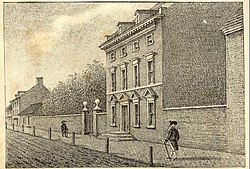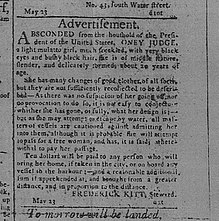
The Liberty Bell, previously called the State House Bell or Old State House Bell, is an iconic symbol of American independence located in Philadelphia. Originally placed in the steeple of the Pennsylvania State House, the bell today is located across the street in the Liberty Bell Center in Independence National Historical Park. The bell was commissioned in 1752 by the Pennsylvania Provincial Assembly from the London firm of Lester and Pack, and was cast with the lettering "Proclaim LIBERTY Throughout all the Land unto all the Inhabitants Thereof", a Biblical reference from the Book of Leviticus. The bell first cracked when rung after its arrival in Philadelphia, and was twice recast by local workmen John Pass and John Stow, whose last names appear on the bell. In its early years, the bell was used to summon lawmakers to legislative sessions and to alert citizens about public meetings and proclamations.

The Fugitive Slave Act of 1793 was an Act of the United States Congress to give effect to the Fugitive Slave Clause of the U.S. Constitution, which was later superseded by the Thirteenth Amendment, and to also give effect to the Extradition Clause. The Constitution’s Fugitive Slave Clause guaranteed a right for a slaveholder to recover an escaped slave. The subsequent Act, "An Act respecting fugitives from justice, and persons escaping from the service of their masters", created the legal mechanism by which that could be accomplished.

Independence National Historical Park is a federally protected historic district in Philadelphia, Pennsylvania that preserves several sites associated with the American Revolution and the nation's founding history. Administered by the National Park Service, the 55-acre (22 ha) park comprises many of Philadelphia's most-visited historic sites within the Old City and Society Hill neighborhoods. The park has been nicknamed "America's most historic square mile" because of its abundance of historic landmarks.

Samuel Fraunces was an American restaurateur and the owner/operator of Fraunces Tavern in New York City. During the Revolutionary War, he provided for prisoners held during the seven-year British occupation of New York City (1776-1783), and claimed to have been a spy for the American side. At the end of the war, it was at Fraunces Tavern that General George Washington said farewell to his officers. Fraunces later served as steward of Washington's presidential household in New York City (1789–1790) and Philadelphia (1791–1794).

The Germantown White House is a historic mansion in the Germantown section of Philadelphia, Pennsylvania. It is the oldest surviving presidential residence, having twice housed Founding Father George Washington during his presidency.

William Lee, also known as Billy or Will Lee, was an American slave and personal assistant of George Washington. He was the only one of Washington's slaves who was freed immediately by Washington's will. Because he served by Washington's side throughout the American Revolutionary War and was sometimes depicted next to Washington in paintings, Lee was one of the most publicized African-Americans of his time.
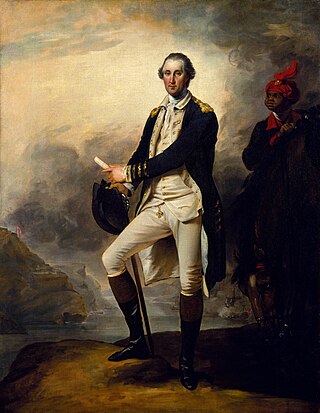
The history of George Washington and slavery reflects Washington's changing attitude toward the ownership of human beings. The preeminent Founding Father of the United States and a hereditary slaveowner, Washington became increasingly uneasy with it. Slavery was then a longstanding institution dating back over a century in Virginia where he lived; it was also longstanding in other American colonies and in world history. Washington's will provided for the immediate emancipation of one of his slaves, and additionally required his remaining 123 slaves to serve his wife and be freed no later than her death, so they ultimately became free one year after his own death.
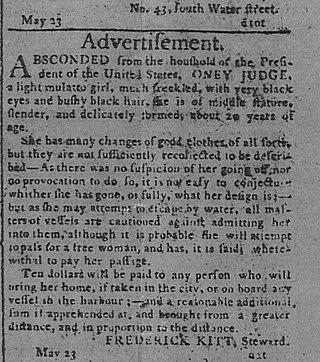
Ona "Oney" Judge Staines was a biracial woman who was enslaved by the Washington family, first at the family's plantation at Mount Vernon and later, after George Washington became president, at the President's House in Philadelphia, then the nation's capital city. In her early twenties, she absconded, becoming a fugitive slave, after learning that Martha Washington had intended to transfer ownership of her to her granddaughter, known to have a horrible temper. She fled to New Hampshire, where she married, had children, and converted to Christianity. Though she was never formally freed, the Washington family ultimately stopped pressing her to return to Virginia after George Washington's death.
Hercules Posey was an enslaved African owned by George Washington, at his plantation Mount Vernon in Virginia. "Uncle Harkless," as he was called by George Washington Parke Custis, served as chief cook at the Mansion House for many years. In November 1790, Hercules was one of eight enslaved Africans brought by President Washington to Philadelphia, Pennsylvania, then the temporary national capital, to serve in the household of the third presidential mansion.

Christopher Sheels, was a slave and house servant at George Washington's plantation, Mount Vernon, in Virginia, United States.

An Act for the Gradual Abolition of Slavery, passed by the Fifth Pennsylvania General Assembly on 1 March 1780, prescribed an end for slavery in the Commonwealth of Pennsylvania in the United States. It was the first slavery abolition act in the course of human history to be adopted by a democracy.

The Samuel Osgood House, also known as the Walter Franklin House, was the first official residence of the President of the United States. It housed George Washington, his family, and household staff, from April 23, 1789, to February 23, 1790, during New York City's two-year term as the national capital. Demolished in 1856, it stood at the northeast corner of what was Pearl and Cherry streets in what is now Civic Center, Manhattan, New York City.

The Alexander Macomb House at 39–41 Broadway in Lower Manhattan, New York City, served as the second U.S. Presidential Mansion. President George Washington occupied it from February 23 to August 30, 1790, during New York City's two-year term as the national capital. The building was demolished in 1940, the last former U.S. presidential mansion to be demolished.

Ramin Ganeshram is an American journalist, food writer, and novelist. She is known for her work in polycultural American history and historic foodways.
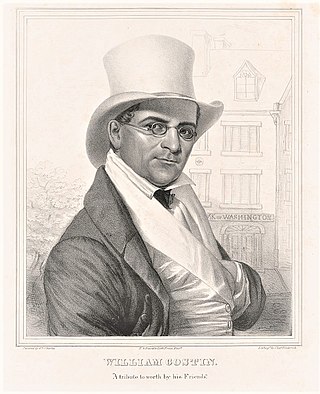
William Costin was a free African-American activist and scholar who successfully challenged District of Columbia slave codes in the Circuit Court of the District of Columbia.
Betty was a biracial enslaved woman owned by Martha Washington. She was owned by the Custis Estate and worked at Daniel Parke Custis' plantation, the White House, on the Pamunkey River in New Kent County, Virginia. Custis married Martha Dandridge in 1750 and, when he died in 1757, Betty became one of Martha's dower slaves whom she brought to George Washington's plantation, Mount Vernon, after the Washington marriage in 1759. Betty worked at Mount Vernon until she died.
Sarah Johnson was an African American woman who was born into slavery at Mount Vernon, George Washington's estate in Fairfax, Virginia. She worked as a domestic, cleaning and caring for the residence. During the process, she became an informal historian of all of the mansion's furnishings. After the end of the Civil War, she was hired by the Mount Vernon Ladies' Association, ultimately becoming a council member of the organization. She bought four acres of Mount Vernon land to establish a small farm. The book Sarah Johnson's Mount Vernon (2008) tells the story of her life within the complex community of people who inhabited Mount Vernon.

Caroline Branham (1764–1843) was an enslaved housemaid and seamstress of George and Martha Washington. She was married to Washington's hired groomsman Peter Hardiman, whose slaveholder was David Stuart. Branham gave birth to nine children, seven with Hardiman. Her son, Austin (1798-1879) and her ninth child, Lucy, are believed to have been a child of the plantation; the boy's and girl's father was George Washington Parke Custis. Branham served the Washington family and their many visitors, ensuring that they resided in comfort.
